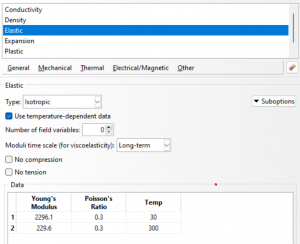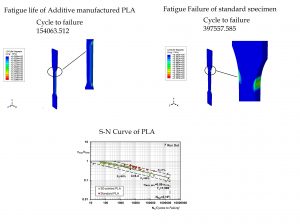In this study we have compared the fatigue life of Additive manufactured Poly lactic acid PLA specimen vs the standard specimen using a standard pull out test as a load case history for fatigue. PLA is a biodegradable, absorbable and biocompatible thermoplastic aliphatic polyester that is widely used for
rapid prototyping, to manufacture tools, jigs, and fixtures designed to maximize the production efficiency, and to make
biomedical components with complex shape[1]. PLA is modelled as an elasto plastic material with yielding strength of 56 MPA and ultimate tensile strength of 58 MPA due to its brittle behavior. The material properties of PLA are shown in Figure below :

As we are doing thermo-mechanical simulation so apart from this the properties like thermal conductivity and specific heat must be defined apart from the mechanical properties. These properties were taken from various online resources and literature. First step in the simulation is fabrication of the 3D printed specimen using FFF Fused filament fabrication technique. In this technique the heated extruder melt a wire/beads layer by layer and upon colling it condensed into the resulting specimen. First of all a STL file is created in Abaqus as shown in figure below

As the Problem with Abaqus is when we import the specimen as STL it convert the STL into Shell file so in order to avoid this issue the inp file of Abaqus is imported into finite element modeler module in Ansys and then resulting STL file is exported for generating G codes using various 3D printer. This STL file is then exported to 3D printer like Prusa slicer or replicator for G code generation. As abaqus cannot recognize the G codes , as we need to convert them in to X Y and Z coordinates. So in order to avoid this i have manually generated a path using Abaqus point tracking method and then manipulated the data into he EXVEL sheet in order to get desired Input for Abaqus as shown in figure below

The excel sheet data is then imported as event series input data into the AM plugin which is the plug in used to model the 3D printing in Abaqus. Two different steps were created . In the first step the 3D printing is performed using heat transfer step and in the second case the cooling is performed in order to monitor the residual stresses during the printing process. The resulting of both steps are shown in figure below:

In the next phase a pull out test in performed with and with out residual stresses in order to create a load history for Fatigue input. For this one end of the specimen is fixed and displacement of 1 mm is applied on the opposite end.
Following are the results of pull out test on 3D printed specimen incorporating the residual stresses

The result of tensile pull out test on standard PLA specimen in shown in figure below:

By comparing the above two figures we can observe that that the stresses generated in the 3D printed specimen are greater as compared to the standard specimen due to inclusion of residual stresses.
For assessing the fatigue life of both specimen, the resulting file were exported into the FE_SAFE software in order to predict the fatigue life. A sinusoidal load case history was used for both specimen and the resulting fatigue life is predicted using S-N curve based approach. The S-N curve of the PLA is taken from the literature. The result of the failure cycle are summarized in figure below :

From the Above figure it is is clear that fatigue failure cycle for 3D printed specimen is approximately 154k while for the standard specimen it is estimated as 397k i.e. almost twice as greater from the 3D printed specimen. It means that the fatigue life of 3D printed specimen is half as compared to the standard specimen. This is due to fact, in our case the rapid cooling was performed which results in high stress accumulation due to which fatigue life pf the #d printed specimen decreased.
Please feel free to reach out to me in case of any queries
Thanks
Arsalan
Email # arsalanmuhammadahmad@yahoo.com
References:
- On the fatigue strength of 3D-printed polylactide (PLA)